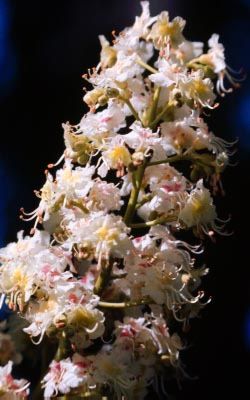Genus: Aesculus
Nomenclature
Aesculus L., Sp. Pl. 344. 1753. Gen. Pl. 161. 1754 (also spelled “Esculus” and “Oesculus”). Hippocastanum Mill., Gard. Dict. Abr. ed. 4. 1754 nom. illeg. (Art. 52.1). Pawia Kuntze, Revis. Gen. Pl. 1: 145. 1891 nom. illeg. (Art. 52.1). LECTOTYPE: Aesculus hippocastanum L. designated by Britton & Brown (1913).Pavia Mill., Gard. Dict. abr. ed. 4. 1754. TYPE: Pavia octandria Mill. (Aesculus pavia L.).
Paviana Raf., Fl. Ludov. 87. 1817. TYPE: Unknown.
Neobropsis Raf., Alsogr. Amer. 68. 1838. TYPE: Unknown.
Key to the species of Aesculus
1. Flowers about 2 cm across...Aesculus hippocastanum1. Flowers about 1 cm across...Aesculus parviflora
List of Aesculus Species
References to Aesculus
- Ames, O. I. 1939. Survey of hurricane damage at Mount Auburn Cemetery, Cambridge, Massachusetts. Arborist's News 4(1): 5-6.
- Anonymous 1893. Proceedings of the club. Bull. Torrey Bot. Club 20: 222.
- Avery, G. S.; Burkholder, P. R.; Creighton, H. B. 1937. Production and distribution of growth hormone in shoots of Aesculus and Malus, and its probable role in stimulating cambial activity. Amer. J. Bot. 24: 51-8.
- Barden, L. S. 1983. Size, age, and growth rate of trees in canopy gaps of a cove hardwood forest in the southern Appalachians. Castanea 48: 19-23.
- Borthwick, H. A. 1957. Light effects on tree growth and seed germination. Ohio J. Science 57: 357-64.
- Brizicky, George K. 1963. The genera of Sapindales in the southeastern United States. J. Arnold Arbor. 44: 462-501.
- Bush, B. F. 1930. Notes on Aesculus species. Amer. Midl. Naturalist 12: 19-26.
- Carpenter, S. B.; Smith, N. D. 1979. Variation in shade leaf thickness among urban trees growing in metropolitan Lexington, Kentucky. Castanea 44: 94-8.
- Carpenter, S. B.; Smith, N. D. 1981. A comparative study of leaf thickness among southern Appalachian hardwoods. Canad. J. Bot. 59: 1393-6.
- Chadwick, L. C. 1939. New England hurricane damage to trees. Arborist's News 4(1): 1-4.
- Chaffey, N.; Barnett, J.; Barlow, P. 1997. Endomembranes, cytoskeleton, and cell walls: aspects of the ultrastructure of the vascular cambium of taproots of Aesculus hippocastanum L. (Hippocastanaceae). Int. J. Plant Sci. 158: 97-109.
- Collingwood, G. H. 1942. Horeschesnut. Amer. Forests 48: 272-3.
- Downs, R. J.; Borthwick, H. A. 1956. Effects of photoperiod on growth of trees. Bot. Gaz. 117(4): 310-26.
- Forest, F. et.al. 2001. A morphological phylogenetic analysis of Aesculus L. and Billia Peyr. (Sapindaceae). Canad. J. Bot. 79: 154-169.
- Fostad, O.; Pedersen, P. A. 1998. Progeny testing in street trees subjected to roadside soil pollution. J. Arboric. 24: 127-34.
- Foster, A. S. 1929. Investigations on the morphology and comparative history of development of foliar organs. I. The foliage leaves and cataphyllary structures in horsechestnut (Aesculus hippocastanum L.). Amer. J. Bot. 16: 441-501.
- Hall, B. A. 1947. The floral anatomy of the Aceraceae and some related families. Ph.D. Dissertation Cornell Univ., Ithaca, NY25 plates + 82 p.
- Hardin, J. W. 1957. Studies in the Hippocastanaceae, IV. Hybridization in Aesculus. Rhodora 59(704): 185-203.
- Hardin, J. W. 1955. Studies in the Hippocastanaceae. I. Variation within the mature fruit of Aesculus. Rhodora 57(674): 37-42.
- Hardin, J. W. 1960. Studies in Hippocastanaceae, V. Species of the Old World. Brittonia 12(1): 26-38.
- Harris, A. J. et.al. 2009. Phylogeny, origin, and biogeographic history of Aesculus L. (Sapidales)- an update from combined analysis of DNA sequences, morphology, and fossils. Taxon 58: 108-126.
- Heaslip, M. B. 1959. Effects of seed irradiation on germination and seedling growth of certain deciduous trees. Ecology 40(3): 383-8.
- Hoar, C. S. 1927. Chromosome studies in Aesculus. Bot. Gaz. 84: 156-70.
- Holden, R. 1912. Some features in the anatomy of the Sapindales. Bot. Gaz. 53: 50-8.
- Isenberg, I. H. 1956. Papermaking fibers. Econ. Bot. 10(2): 176-93.
- Lack, H. W. 2002. The discovery and rediscovery of the horse chestnut. Arnoldia (Jamaica Plain) 61: 15-19.
- Lim, H. W.; Pelikan, S.; Rogstad, S. H. 2002. Genetic diversity among populations and size classes of buckeyes (Aesculus: Hippocastanaceae) examined with multilocus VNTR probes. Pl. Syst. Evol. 230: 125-141.
- Llewellyn-Jones, J. 1977. The history of a plant: 3. The horse chestnut- Aesculus hippocastanum L. Basildon Nat. Hist. Soc. Bull. 49: 3-4.
- Lumis, G. P.; Hofstra, G.; Hall, R. 1973. Sensitivity of roadside trees and shrubs to aerial drift of deicing salt. Hortscience 8: 475-7.
- Lumis, G. P.; Hofstra, G.; Hall, R. 1975. Salt damage to roadside plants. J. Arboric. 1(1): 14-6.
- Macior, L. W. 1978. Pollination ecology of vernal angiosperms. Oikos 30: 452-460.
- McInteer, B. B. 1947. Soil preference of some plants as seen in Kentucky. Castanea 12: 1-8.
- Merz, R. W. 1957. Silvical characteristics of Ohio buckeye. USDA Forest Serv. Centr.
- Muller, D. 1949. Adventitious roots from trunk of horsechestnut. Dansk Skofor. Tidsskr. 34: 527-8. (In Danish)
- Newell, J. H. 1893. The flowers of the horsechestnut. Bot. Gaz. 18: 107-9.
- Ostergaard, J. 1957. The horsechestnut. Horticultura 11: 107-11. (In Danish)
- Pammel, L. H.; King, C. M. 1918. The germination of some trees and shrubs and their juvenile forms. Proc. Iowa Acad. Sci. 25: 291-340.
- Pelletier, M. 1935. Recherches cytologiques sur l' Aesculus hippocastanum L. Le Botaniste 27: 279-322. (In French)
- Robertson, C. 1896. Flowers and insects. Trans. St. Louis Acad. Sci. 7: 151-179.
- Skovsted, A. 1929. Cytological investigations of the genus Aesculus. Hereditas 12: 64-70.
- Small, J. K. 1917. Aesculus parviflora. Addisonia 2: 45-6.
- Warrillow, M.; Mou, P. 1999. Ice storm damage to forest tree species in the ridge and valley region of southwestern Virginia. J. Torrey Bot. Soc. 126: 147-158.
- Xiang, Q. Y. et.al. 1998. Origin and biogeography of Aesculus L. (Hippocastanaceae): a molecular phylogenetic perspective. Evolution 52: 988-997.
- Yetter, T. C.; Runkle, J. R. 1986. Height growth rates of canopy tree species in southern Appalachian gaps. Castanea 51: 157-67.
- dePamphilis, C. W.; Wyatt, R. 1990. Electrophoretic confirmation of interspecific hybridization in Aeculus (Hippocastanaceae) and the genetic structure of a broad hybid zone. Evolution 44: 1295-317.
